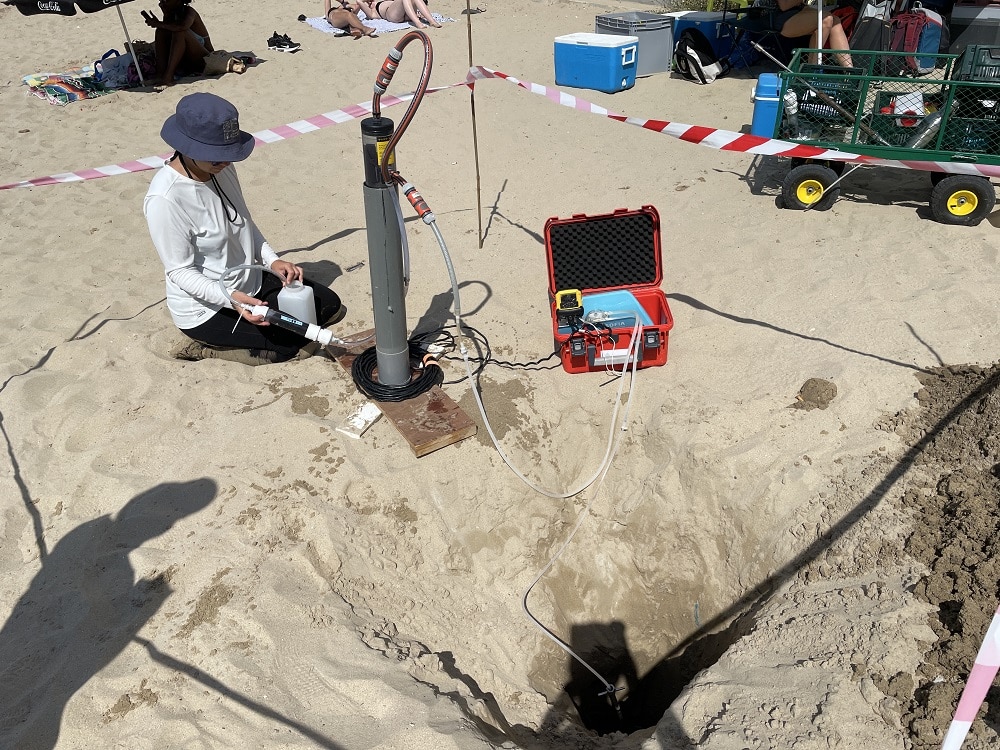Under the beach, water circulates at shallow depths in the porous sandy substrate. This is a little-known aquatic ecosystem, influenced by seawater intrusions and freshwater from the catchment area. When the beach is located in the heart of a large city, in an urbanised bay, the anthropogenic pressures multiply.
Is there a link between beach use and the functioning and quality of this underground ecosystem? This is the question addressed by the MICROBEACH project, through the prism of sunscreens.
Funded by the Institut des Sciences de l'Océan (AMU) and supported by the MIO, this multidisciplinary project combines basic sciences and humanities and brings together researchers in environmental chemistry (Virginie Sanial, MIO; Jean-Luc Boudenne, LCE), microbial ecology (Nicolas Gallois, Léopold Matthys and Benjamin Misson, MIO) and environmental geographers (Emanuele Giordano, BABEL; Samuel Robert and Marie-Laure Trémélo, ESPACE). It aims to structure the research efforts of UTLN and AMU in order to :
- explore the potential for microbial biodegradation of organic UV filters in the subterranean environment of beaches,
- to assess the number of visitors to and use of the Plage des Catalans, a natural beach in the heart of Marseille.
The funding enabled the recruitment in June 2024 of a post-doctoral fellow in microbial ecotoxicology, who is coordinating observation and sampling campaigns, as well as laboratory experiments to address these objectives.
The city of Marseille supported the project by issuing a municipal order authorising an initial field campaign on 28 August, enabling a team of around twenty scientists to set to work in the midst of hundreds or even thousands of beach-goers, depending on the time of day (~1600 people at the peak). From six o'clock in the morning, the scientists set up thirteen sampling sites on the beach. Sampling began as soon as possible in order to gradually free up the space for users.
In total, ten hours of sampling and filtering were carried out in the field and then in the laboratory, twelve hours of visitor assessment (counting people entering and leaving the beach, taking photographs to count people in the water and on the sand) and 136 surveys of people present to assess their use of the beach and sun creams were carried out on 28 August alone.
This event, which intrigued the area's many regulars and tourists, as well as the local press [1] and national [2] would not have been possible without the help of colleagues from the various partner laboratories in preparing, carrying out and now interpreting the observations.
The next stage of MICROBEACH will involve an experimental approach in the laboratory to assess the potential for biodegradation of organic UV filters in sunscreens by microorganisms in groundwater. During the winter, a second sampling and survey campaign will be carried out during the low-traffic period in order to estimate the persistence of UV filters on (but above all under) the beaches.
Lastly, funding for this project will enable international experts in the various disciplines needed to explore this issue in an integrated way to be brought together at a scientific workshop in late spring. The results will be disseminated to beach users and local authorities, who will be open to scientific expertise when considering future developments.



[1] Listen from 1 hour 10 minutes into the programme, during the 6 o'clock news. written version.
[2] Project participants: Kiara Esteves Ramos, Nicolas Gallois, Léopold Matthys, Benjamin Misson and Virginie Sanial (MIO); Emanuele Giordano (BABEL); Samuel Robert, Marie-Laure Trémélo (ESPACE), Jean-Luc Boudenne (LCE). Thanks for their help in the field: Clara Dignan, Florian Haitz, Coraline Mattei, Isabelle Navarro, Marie Noguer, Benjamin Oursel, Hélène Plihon, Anne-Hélène Prime, Gwénola Simon, Léa Sylvi, Corinne Valette (MIO); Vincent Bottelin, Carine Fournier.




